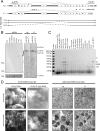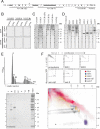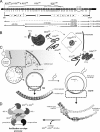Rendezvin: An essential gene encoding independent, differentially secreted egg proteins that organize the fertilization envelope proteome after self-association
- PMID: 17005910
- PMCID: PMC1679687
- DOI: 10.1091/mbc.e06-07-0634
Rendezvin: An essential gene encoding independent, differentially secreted egg proteins that organize the fertilization envelope proteome after self-association
Abstract
Preventing polyspermy during animal fertilization relies on modifications to the egg's extracellular matrix. On fertilization in sea urchins, the contents of cortical granules are secreted and rapidly assemble into the egg's extracellular vitelline layer, forming the fertilization envelope, a proteinaceous structure that protects the zygote from subsequent sperm. Here, we document rendezvin, a gene whose transcript is differentially spliced to yield proteins destined for either cortical granules or the vitelline layer. These distinctly trafficked variants reunite after cortical granule secretion at fertilization. Together, they help coordinate assembly of the functional fertilization envelope, whose proteome is now defined in full.
Figures





Similar articles
-
Diversity in the fertilization envelopes of echinoderms.Evol Dev. 2013 Jan;15(1):28-40. doi: 10.1111/ede.12012. Evol Dev. 2013. PMID: 23331915 Free PMC article.
-
SFE1, a constituent of the fertilization envelope in the sea urchin is made by oocytes and contains low-density lipoprotein-receptor-like repeats.Biol Reprod. 2000 Dec;63(6):1706-12. doi: 10.1095/biolreprod63.6.1706. Biol Reprod. 2000. PMID: 11090439
-
Behaviour of the vitelline envelope in Bufo arenarum oocytes matured in vitro in blockade to polyspermy.Zygote. 2006 May;14(2):97-106. doi: 10.1017/S0967199406003662. Zygote. 2006. PMID: 16719945
-
Structure and function of the egg cortex from oogenesis through fertilization.Dev Biol. 2002 Jan 1;241(1):1-23. doi: 10.1006/dbio.2001.0474. Dev Biol. 2002. PMID: 11784091 Review. No abstract available.
-
Fertilization-induced changes in the vitelline envelope of echinoderm and amphibian eggs: self-assembly of an extracellular matrix.J Electron Microsc Tech. 1991 Mar;17(3):294-318. doi: 10.1002/jemt.1060170305. J Electron Microsc Tech. 1991. PMID: 2045963 Review.
Cited by
-
Extracellular matrix modifications at fertilization: regulation of dityrosine crosslinking by transamidation.Development. 2009 Jun;136(11):1835-47. doi: 10.1242/dev.030775. Epub 2009 Apr 29. Development. 2009. PMID: 19403662 Free PMC article.
-
Diversity in the fertilization envelopes of echinoderms.Evol Dev. 2013 Jan;15(1):28-40. doi: 10.1111/ede.12012. Evol Dev. 2013. PMID: 23331915 Free PMC article.
-
Egg Coat Proteins Across Metazoan Evolution.Curr Top Dev Biol. 2018;130:443-488. doi: 10.1016/bs.ctdb.2018.03.005. Epub 2018 May 7. Curr Top Dev Biol. 2018. PMID: 29853187 Free PMC article. Review.
-
Membrane hemifusion is a stable intermediate of exocytosis.Dev Cell. 2007 Apr;12(4):653-9. doi: 10.1016/j.devcel.2007.02.007. Dev Cell. 2007. PMID: 17420001 Free PMC article.
-
Dachsous1b cadherin regulates actin and microtubule cytoskeleton during early zebrafish embryogenesis.Development. 2015 Aug 1;142(15):2704-18. doi: 10.1242/dev.119800. Epub 2015 Jul 9. Development. 2015. PMID: 26160902 Free PMC article.
References
-
- Andersen O. M., Christensen L. L., Christensen P. A., Sorensen E. S., Jacobsen C., Moestrup S. K., Etzerodt M., Thogersen H. C. Identification of the minimal functional unit in the low density lipoprotein receptor-related protein for binding the receptor-associated protein (RAP). A conserved acidic residue in the complement-type repeats is important for recognition of RAP. J. Biol. Chem. 2000;275:21017–21024. - PubMed
-
- Bisgrove B. W., Raff R. A. The SpEGF III gene encodes a member of the fibropellins: EGF repeat-containing proteins that form the apical lamina of the sea urchin embryo. Dev. Biol. 1993;157:526–538. - PubMed
-
- Bork P., Beckmann G. The CUB domain. A widespread module in developmentally regulated proteins. J. Mol. Biol. 1993;231:539–545. - PubMed
-
- Bruskin A. M., Tyner A. L., Wells D. E., Showman R. M., Klein W. H. Accumulation in embryogenesis of five mRNAs enriched in the ectoderm of the sea urchin pluteus. Dev. Biol. 1981;87:308–318. - PubMed
MeSH terms
Substances
LinkOut - more resources
Full Text Sources
Miscellaneous

